
Coimbatore, sometimes shortened as Kovai, is one of the major metropolitan cities in the Indian state of Tamil Nadu. It is located on the banks of the Noyyal River and surrounded by the Western Ghats. Coimbatore is the second largest city in Tamil Nadu after Chennai in terms of population and the 16th largest urban agglomeration in India as per the census 2011. It is administered by the Coimbatore Municipal Corporation and is the administrative capital of Coimbatore District. In 1981, Coimbatore formed as the third municipal corporation in Tamil Nadu after Chennai and Madurai. Podanur Junction is the oldest railway station in Coimbatore City. The city is one of the largest exporters of jewellery, wet grinders, poultry and auto components; the "Coimbatore Wet Grinder" and the "Kovai Cora Cotton" are recognised as Geographical Indications by the Government of India. Being a hub of textile industry in South India, the city is sometimes referred to as the "Manchester of South India". It was ranked the 7th best city in India in the Ease of Living index 2020.

Salem, natively spelt as Selam, is a major city in Salem district, located on the banks of the Thirumanimutharu river in the Indian state of Tamil Nadu. Salem is the fifth largest urban agglomeration in the state, exceeded by Chennai, Coimbatore, Madurai, and Tiruchirappalli, and third largest metropolitan region in the state only after to Chennai and Coimbatore metropolitan regions. The city is 124 km2 (48 sq mi) large. Major products of Salem include silver anklets, sago, mangoes, steel, and textiles.
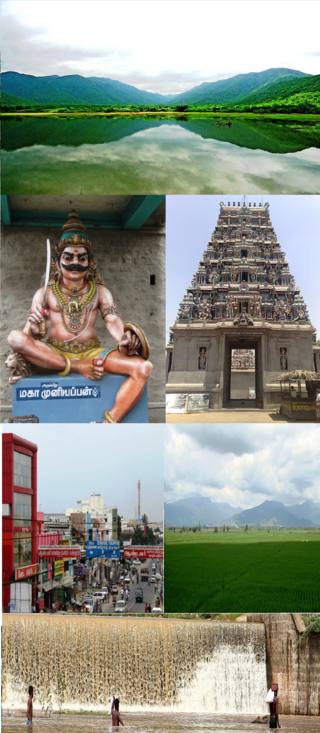
Gobichettipalayam is the Selection grade municipality in the Indian state of Tamil Nadu. It is the administrative headquarters of Gobichettipalayam taluk. It is situated at the center of the South Indian Peninsula, 35 kilometres (22 mi) from the district headquarters Erode, 44 kilometres (27 mi) from Tiruppur and 80 kilometres (50 mi) from Coimbatore. Agriculture and textile industries contribute majorly to the economy of the town and the town is situated at 213 metres (699 ft) above sea level, surrounded by Western Ghats. The town is a part of Gobichettipalayam constituency and the Tirupur constituency that elects its member of parliament. The town is administered by a municipality established in 1949 and has a population of 65,238 as of 2011. It is known as "Mini Kollywood" because of the film shooting that takes place here and many films in Tamil and other languages have been shot.

Kongu Nadu, also known by various names such as Kongu Mandalam and Kongu belt, is a geographical region comprising present day parts of western Tamil Nadu, southeastern Karnataka and eastern Kerala. In the ancient Tamilakam, it was the seat of the Chera kings, bounded on the east by Tondai Nadu, on the south-east by Chola Nadu and on the south by Pandya Nadu regions.

Dheeran Chinnamalai was a Palayakkarar and chieftain who ruled the Kongu Nadu region of the present day western Tamil Nadu. He fought against the British East India Company, was later captured and hanged by the British.

Coimbatore district is one of the 38 districts in the state of Tamil Nadu in India. Coimbatore is the administrative headquarters of the district. It is one of the most industrialized districts and a major textile, industrial, commercial, educational, information technology, healthcare and manufacturing hub of Tamil Nadu. The region is bounded by Tiruppur district in the east, Nilgiris district in the north, Erode district in the northeast, Palakkad district, Idukki district and small parts of Thrissur district and Ernakulam district of neighboring state of Kerala in the west and south respectively. As of 2011, Coimbatore district had a population of 3,458,045 with a sex ratio of 1,000 and literacy rate of 84%.

The Kombai or Polygar dog is a breed of working dog native to Tamil Nadu in Southern India. Traditionally kept for guarding and protection, they have a reputation for making excellent guard dogs. They were also occasionally used for hunting big games.

The Dindigul Fort or Dindigul Malai Kottai and Abirami amman Kalaheswarar Temple was built in 16th-century by Madurai Nayakar Dynasty situated in the town of Dindigul in the state of Tamil Nadu in India. The fort was built by the Madurai Nayakar king Muthu Krishnappa Nayakar in 1605. In the 18th century the fort passed on to Kingdom of Mysore. Later it was occupied by Hyder Ali and Tipu Sultan the fort was of strategic importance. In 1799 it went to the control of the British East India Company during the Polygar Wars. There is an abandoned temple on its peak apart from few cannons sealed with balls inside. In modern times, the fort is maintained by the Archaeological Survey of India and is open to tourists.
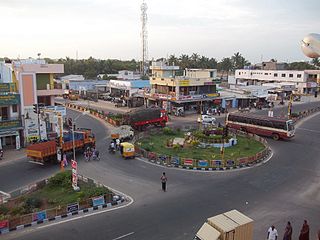
Dharapuram is a town situated along the banks of Amaravati River in Tiruppur district in the Indian state of Tamil Nadu. Dharapuram is one of the oldest towns in South India and was the capital of Kongu Nadu under the Cheras, Western Ganga Dynasty and later Kongu Cholas, at which time it was known as Viradapuram. Amaravathi River flows through the town. As of 2011, the town had a population of 67,007. The city houses famous temples including Agatheeswarar Temple, Kaadu Hanumanthasamy temple and many others.

Central Studios was an Indian film studio in the neighbourhood of Singanallur, Coimbatore in Tamil Nadu, started by B.Rangaswamy Naidu and other prominent industrialists like Swamikannu Vincent of Coimbatore in 1935 to make Tamil and other South Indian language movies. The studio was a major hub of Tamil movie production and notable for its association with many early day Tamil Movie Superstars, directors and script writers etc. and many making their career debuts here. The studio is best remembered for movies like Sivakavi, Velaikari and Haridas.
Mopeds India Limited was a two wheeler manufacturer based in India, which manufactured and sold the Suvega range of Mopeds under technical collaboration with Motobécane of France. Its first model was the Motobécane Mobylette sold under the name Suvega Super 50. It was the first company in India to launch Mopeds in India which was the largest selling two-wheeler segment till 80's and was India's largest selling moped till early 80's.

The Madras Presidency was a province of British India comprising most of the present day Tamil Nadu and Andhra Pradesh along with a few districts and taluks of Karnataka, Kerala and Odisha. A few princely states, notably Ramnad and Pudukkottai also merged into the Presidency at some or the other time. The Presidency lasted till 1950, when it became the Madras State after India became a republic. In 1953, Telugu-speaking regions of the state split to form Andhra State. Subsequently, in 1956, Kannada- and Malayalam-speaking areas were merged with Mysore and Travancore-Cochin respectively.
Economy of Coimbatore is heavily influenced by information technology, engineering and textiles. Coimbatore is called the Manchester of South India due to its extensive textile industry, and IT industry, small and medium scale enterprise gdp(gross domestic product) of Coimbatore city is around $20 billion in 2021.It is second largest city by GDP in Tamil Nadu. The city has four special economic zones [SEZ], ELCOT SEZ, KGISL SEZ, SPAN Venture SEZ, Aspen SEZ and at least five more SEZs are in the pipeline. In 2010, Coimbatore ranked 15th in the list of most competitive Indian cities.

Karur was built on the banks of River Amaravathi which was called Aanporunai during the Sangam days. The names of the early Chera kings who ruled from Karur, have been found in the rock inscriptions in Aru Nattar Malai close to Karur. The Tamil epic Silapathikaram mentions that the famous Chera King Senguttuvan ruled from Karur. The ancient Greek scholar Ptolemy is said to have known Karur by the name Korevera or Kāroura, placing it as a major trading centre in the region
Coimbatore, also known as Kovai, is the second largest city in the Indian state of Tamil Nadu with a metropolitan population of over 2 million. It is a major commercial centre and has often been referred to as the "Manchester of South India".
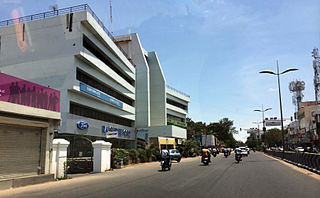
Avinashi Road, is an arterial road in Coimbatore, India. Running from east to west, the road starts at Uppilipalayam flyover and ends at Neelambur by-pass junction where it joins NH 544, Beyond Neelambur Junction, the road branches into two, with one traversing southwards to Madukarai to form the Coimbatore bypass while the other continues westwards to Avinashi and beyond to form the National Highway 544. This road connects Coimbatore to its airport and the east and north-east suburbs. The road was an indicator of development as the city of Coimbatore grew up mostly along its eastern and western sides.
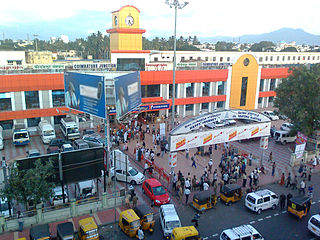
Coimbatore or Kovai is a major city in the Indian state of Tamil Nadu. It is the second largest city and urban agglomeration in the state after Chennai and the sixteenth largest urban agglomeration in India. It is administered by the Coimbatore Municipal Corporation and is the administrative capital of Coimbatore district. It is one of the fastest growing tier-II cities in India and a major textile, industrial, commercial, educational, information technology, healthcare and manufacturing hub of Tamil Nadu. It is often referred to as the "Manchester of South India" due to its cotton production and textile industries.
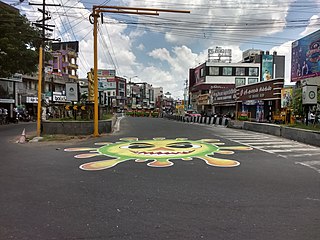
Tiruppur or Tirupur ( ) is a city in the Indian state of Tamil Nadu. Tiruppur is the administrative headquarters of Tiruppur district and the fifth largest city as well as an urban agglomeration in Tamil Nadu. Located on the banks of Noyyal River, it has been ruled at different times, by the Early Pandyas, Medieval Cholas, Later Cholas, Mysore Kingdom and also British. It is about 450 kilometres (280 mi) southwest of the state capital Chennai, about 50 kilometres (31 mi) east of Coimbatore, 50 kilometres (31 mi) south of Erode, and 50 kilometres (31 mi) north of Dharapuram.

This is a timeline list of major events in the history of Coimbatore, a major city in the Indian state of Tamil Nadu.



















